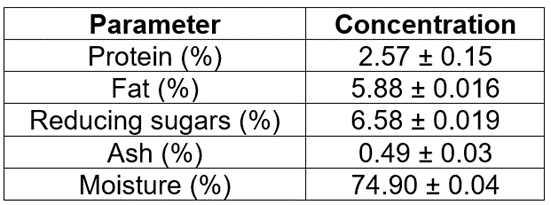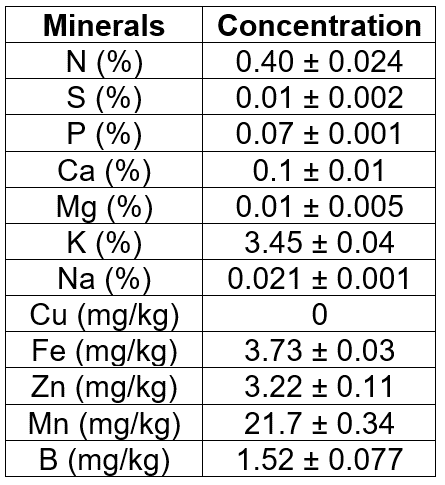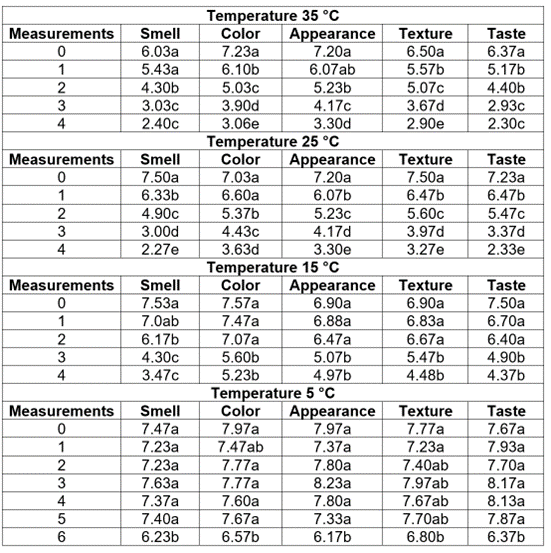INTRODUCTION
Yogurt is a highly nutritional food that originates from the fermentation of milk by the action of lactic acid bacteria (LAB) (Bai et al. 2020; Yang et al. 2021). This milk by-product is widely consumed because of its healthy, nutritious, and sensorial properties. In addition, it has nutraceutical, therapeutic, and anticancer properties and reduces cholesterol. From a chemical perspective, yogurt is made of a complex gel system that incorporates proteins, polysaccharides, and lipids into its structure. It and other dairy by-products (cheese, fermented milk drinks, butter) are mainly made from cow's milk, although milk from other mammals is also used, resulting in different sensory and physicochemical characteristics because of differences in the composition of the milk (Tamime & Robisons, 2007).
As a result of its composition and optimal yield, buffalo milk has become an alternative raw material to increase the variety of dairy products with qualities different from those traditionally made with cow milk (Andrade P. et al. 2009; Patiño, 2011; Simões Da Silva et al. 2020). Buffalo milk has its characteristics compared to other kinds of milk. These qualities contribute to its identification from a nutritional point of view (higher fat, protein, lactose, lower cholesterol level, and some minerals such as calcium, iron, magnesium, and phosphorus) and sensory (Andrade et al. 2010). Furthermore, buffalo milk by-products have better gel consistency and higher creaminess thanks to their higher casein content and high-fat content, respectively (Sfakianakis & Tzia, 2014).
The food industry has become increasingly interested in finding new plant sources that provide high nutrient content and health benefits. Aloe vera (Aloe barbadensis Miller) is a plant used in traditional medicine, but recently its gel has been used for cosmetics and functional foods for its diversity of components such as carbohydrates, proteins, fibers, vitamins, minerals, amino acids, and phenolic compounds (Maan et al. 2018; 2021; Ghafoor et al. 2016; Eshun & He 2004). Aloe vera as an ingredient confers to a final product the extension of its shelf life, improvement in antimicrobial properties, and textural characteristics, among others (Das et al. 2011; Benítez et al. 2015; Shahrezaee et al. 2018).
Aloe has been used in products such as beverages, ice cream, nuggets, meat products (Soltanizadeh & Ghiasi-Esfahani, 2015; Shahrezaee et al. 2018; Sharma et al. 2021), in dairy products such as yogurt (Gutiérrez-Álzate et al. 2021; Ikram et al. 2021) and cheese (El-Sayed & El-Sayed, 2020). Therefore, the present research aimed to evaluate the effect of the addition of aloe vera (Aloe barbadensis Miller) on the physicochemical and bromatological characteristics and shelf life of a buffalo milk yogurt.
MATERIALS AND METHODS
Raw material. Buffalo milk was obtained from a dairy company located in Planeta Rica (Córdoba, Colombia). The Aloe vera gel and remaining raw material (sugar, lactic culture, liquid glucose, stabilizer (pectin), citric acid) were acquired in a local market in the city of Montería.
Preparation of the aloe vera sauce. The aloe vera gel was cut into cubes of 1.5 x 1.5 x 1.5 cm. The formulation to prepare the aloe vera sauce was water 50 %, aloe vera cubes 50 %, tablet sugar (sucrose) 8 %, liquid glucose 2 %, stabilizer (xanthan gum) 1 %, and citric acid 0.1 %. The water and glucose were heated at 50 ± 0.5 °C for 5 min. Then, stabilizer and sugar were added and mixed until obtaining a gelatinous and translucent consistency. Afterward, cubes of aloe vera were added. Subsequently, the mixture was pasteurized at 65 ± 0.5 °C for 30 min (The mixture was put into 1 L glass bottles and placed in a water bath) and left to stand for 10 min, and then, citric acid was added. Percentages and materials were determined through preliminary tests.
Sensorial analysis of the aloe vera sauce and yogurt. To select the best formulation of sauce, a group of 30 potential untrained panelists, men, and women between 20 and 30 years, was assembled. A higher (3)- to lower (1) preference ordering test was used to select the best aloe vera sauce formulation (Ramírez-Navas, 2012). Also, a 9-point hedonic test was carried out on all yogurt samples, ranging from "I like it extremely" to "I dislike it extremely", and the parameters of smell, color, appearance, taste, and texture.
Yogurt preparation. The components used to make the buffalo milk yogurt and the aloe vera sauce were buffalo milk 100 %, lactic culture 2 % (Streptococcus thermophilus and Lactobacilus delbrueckii ssp. Bulgaricus starter cultures), sugar 2 %, aloe vera sauce 5, 10 or 15 % (the percentage chosen was made according to the results of the sensory evaluation) and stabilizer (pectin) 1 %. The milk was subjected to quality analysis such as titratable acidity (% lactic acid) (197.05 AOAC), fat (NTC 5860) (Icontec, 2011), and density (15.015 AOAC). Subsequently, pre-heating was done at 37 ± 0.1 °C and homogenized using an Ultra Turrax (IKA, Merck, Germany) at 14000 r.p.m. Then, sugar was added to the milk, and it was pasteurized at 90 ± 0.5 °C for 5 min. This mixture was allowed to cool to 44 ± 0.5 °C to inoculate the lactic cultures. Then, the aloe vera sauce was added for fermentation at 44 ± 0.5 °C for 4 h. Finally, the mixture was stored at 5 °C.
Physicochemical and bromatological characterization. The titratable acidity (% lactic acid) (197.05 AOAC) and pH (945.27 AOAC) were determined for the physicochemical analyses. For the bromatological characterization of the product, the following analyses were carried out: protein (920.152 AOAC), fat (NTC 5860) (Icontec, 2011), reducing sugars (Mulgrave method), ash (942.05 AOAC), moisture (934.06 AOAC) and minerals (nitrogen, sulfur, phosphorus, calcium, magnesium, potassium, sodium, copper, zinc, manganese, boron) (Atomic Absorption Method) (Amellal-Chibane & Benamara, 2011).
Determination of shelf-life as a function of temperature. 120 samples were obtained, which were separated into four groups of 30 samples and stored in sterile recipients in a stabilization chamber at four different temperatures: 5, 15, 25 and 35 °C, for an accelerated shelf-life study for 30 days.
To determine the shelf-life of the yogurt, current regulations for yogurt and kumis in refrigerated hermetic containers were used (Resolución 2310 de 1986 - MinSalud, 1986), which indicate a shelf-life of 21 days. A sample was analyzed on the day of production to establish the initial parameters of the product. Then, each group of samples was analyzed until deterioration, varying the frequency of analysis by considering the preliminary tests: 35 °C, measured every three hours; 25 °C, measured every 12 h; 15 °C, measured every 24 h; and 5 °C, measured every four days. Each group of samples was measured in triplicate for pH and titratable acidity (% lactic acid).
Statistical Analysis. Tukey multiple comparison tests were performed to establish whether there were any significant differences. The sensory analysis results of the aloe vera sauce were subjected to Friedman's order sum test was used to verify if there were differences between the 3 Aloe vera sauce formulations. The shelf-life of the food in days was calculated and predicted with the analytical data using a kinetic/mathematical model known as the Arrhenius equation. Finally, Excel was used for the data, where the linear regression equation was obtained and plotted, obtaining the slope (m), the k0 intercept, and the regression of the line, resulting in the shelf-life in days. All tests were performed in triplicate.
RESULTS AND DISCUSSION
Sensorial analysis of the aloe vera sauce. After assigning a score of 1 to 3 to each sample, the results showed that the preference for the sample with 5 % aloe vera sauce was 56; for the 10 % sample was 57 and for the 15 % sample was 69. According to the results of the Friedman test, the concentration with the highest score (15 % aloe vera) was selected because it had significant differences from the other concentrations (p < 0.05). The panelists perceived a more accentuated and balanced flavor in the yogurt with the 15 % aloe concentration.
Physicochemical and bromatological characterization. The acidity and pH values for the incubation, obtained during the formation of the buffalo milk yogurt with aloe vera, are shown in table 1.
Table 1 Physicochemical analysis for the incubation of the buffalo milk yogurt with aloe vera.

Values are the mean of the triplicate analyses ± standard deviation.
The pH decreased from the beginning of fermentation to the end (4 hours). The final value was similar to that reported by Romeih et al. (2014), who obtained averages of 4.4 for buffalo milk yogurt. The acidity of the yogurt increased as the incubation time increased, as indicated in table 1. This increase was due to the activity of lactic acid bacteria that convert lactose to lactic acid during the fermentation process (Ikram et al. 2021) and might be affected by different conditions, including growth conditions, specific growth rate, fermentation time, and consumption of sugars or amino acids, of which aloe vera is a rich source (Wang et al. 2012).
The results of the bromatological characterization are shown in table 2. The values are the average of triplicate analyses ± the standard deviation. All analyses were done on a dry basis.
Table 2 Bromatological characterization of the buffalo milk yogurt with aloe vera.

Values are the mean of the triplicate analyses ± standard deviation. All analyses were taken on a dry basis.
As shown in table 2, the protein value was 2.57 %, lower than that reported by Akgun et al. (2018), who obtained a percentage of 4.2 for a buffalo milk yogurt with different combinations of probiotics. (Bifidobacterium BB-12®, Lactobacillus acidophilus LA-5®, Stretoccocus thermophilus, and Lactobacillus delbrueckii subsp. bulgaricus). The ash percentage was also lower than obtained by Romeih et al. (2014), who obtained 0.78 % to 0.96 %. These lower values may have been due to various conditions, such as breed, season, feed, and lactation stages, which could have affected some parameters in buffalo milk (Patiño, 2004; Ikram et al. 2021). The fat content was 5.88, higher than that reported by previous studies on Greek yogurt made from cow milk, 3.25 % (Serafeimidou et al. 2012). This higher value was because buffalo milk has higher fat values (Granados et al. 2014). The moisture percentage was similar to that reported by Mahmood et al. (2008), who made yogurt based on buffalo milk, apples, and bananas. The mineral content in the yogurt sample is shown in table 3. It can be said that the amount of minerals is due to the added aloe vera because some authors (Miranda et al. 2009; El-Sayed & El-Sayed, 2020; Gutiérrez-Álzate et al. 2021) indicate that this plant is rich in minerals (Na, Ca, Mg, Zn, K, among others), and can provide levels of these minerals to products where aloe vera is used.
Table 3 Minerals in the buffalo milk yogurt with aloe vera.

Values are the mean of the triplicate analyses ± standard deviation.
Studies have shown that adding aloe vera to fermented milk drinks produces an increase in zinc (1.37 times), iron (1.24 times), calcium (1.35 times) and magnesium (1.59 times) (Hernández & Romagosa, 2014). Patiño et al. (2005) reported Zn, Fe, Mn, and K values in average buffalo milk of 1.468, 2.457, 0.607, and 0.101 mg/kg, respectively, lower than found here, confirming the contribution of aloe vera.
On the other hand, the presence of microminerals such as Mn, 21.7 (±0.34) mg/kg, and Fe, 3.73 (±0.03), facilitate the growth of bacteria of the Lactobacillus genus (Hernández & Romagosa, 2014). Furthermore, previous studies have indicated that both aloe vera juice and pulp promote the development of probiotic bacteria because of their chemical composition (Contreras-Pinzón et al. 2007).
The Na-K ratio obtained with the bromatological characterization of the yogurt was 0.0061 (0.021/3.45), which is a very low value and is favorable since a high Na-K ratio has been related to high blood pressure, heart disease, and strokes (Drewnowski et al. 2014). Likewise, the K-Na ratio of the yogurt was 164.285 (3.45/0.021). Previous studies have reported that isolated populations with a predominance of natural foods, fruits, and vegetables, where the individual intake of potassium exceeds sodium with a potassium-sodium ratio greater than 3, have a very low prevalence of arterial hypertension, which is lower than 3 %.
Determination of shelf-life as a function of temperature. Table 4 shows the results of the inferential analysis for % acidity and pH at each temperature.
Table 4 Result for the % acidity and pH at different measurements in the buffalo milk yogurt with aloe vera.

The same letter in the same column indicates no difference according to Tukey's test.
After ANOVA, there were significant differences in each of the measurements for temperature (p-value <0.05), as shown in table 2. These variables did not indicate product deterioration since the values obtained to time were not outside the ranges permitted by Government Resolution 2310 (MinSalud, 1986). The stability of the acidity and pH variables was related to the presence of multiple bioactive substances in aloe, such as phenols, triterpenoids, and steroid saponins (Akbari et al. 2021).
Dairy products with aloe vera vary in terms of acidity and pH content during several weeks of storage, such as in the case of soft cheese with 15 % aloe vera that decreased its pH from 6.76 to 6.21 and increased its acidity from 0.12 to 0.28 % lactic acid at the fourth week (El-Sayed & El-Sayed, 2020). In contrast, yogurt with aloe vera only varied in acidity between 0.7 to 1.2 % and pH from 4.55 to 4.63 after 5 hours of incubation (Parra Huertas, 2014). The buffalo milk yogurt with aloe vera as a fat substitute reached acidity values between 1.12 and 1.67 % in the third week of storage, and the pH remained between 4.6 and 4.05 (Ikram et al. 2021).
The inferential analysis for the sensory profile at each of the temperatures based on the measurements is presented in table 5. The statistical analysis revealed that the panelists perceived statistically significant differences in the product concerning the days, with the higher scores on day zero that decreased over time.
Table 5 Sensory scores for each temperature in the buffalo milk yogurt with aloe vera.

The same letter in the same column indicates no difference according to Tukey's test.
The highest smell, color, appearance, texture, and taste values were observed at 5 °C temperature. While the lowest smell, texture, and taste were recorded at 35 °C because the recommended storage temperature for dairy products is less than 6 °C according to Government Resolution 2310 (MinSalud, 1986). At 35 °C, scores of 5 were observed from the second and third measurements of smell, appearance, texture, and taste (3 and 6 hours), which are equivalent on the hedonic scale to a rating of indifference, a rejection criterion for our study, evidencing that, at this temperature, a shelf-life of one day was not reached (Hough & Fiszman, 2005).
For all temperatures, color, appearance, and texture had the highest score. The only ones with the lowest score were taste and smell. The latter presented the most critical score because a fermented product such as yogurt is made with a mixed culture of Streptococcus thermophilus and Lactobacillus delbrueckii ssp., Bulgaricus contains lactic acid and acetaldehyde, which add the characteristic aroma to the product. For each temperature, the shelf-life in days was estimated using the Arrhenius equation. Table 6 summarizes these results.
For consumer safety, the smell sensory variable was used to check the shelf life of buffalo milk yogurt with aloe vera because it had the lowest score. Since the temperature of 5 °C was closest to the recommendation for the storage and consumption of yogurt in Resolution 2310, the product's shelf-life was 28 days.
The combination of buffalo milk yogurt with aloe vera can be considered beneficial since the levels of minerals such as Zn, Fe, Mn, and K were increased and parameters such as fat. Likewise, the formulation with 15 % aloe sauce can be established as very good for the industry since the product's shelf life averaged 28.6 days.
















